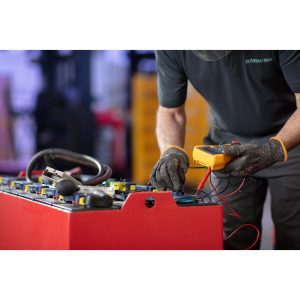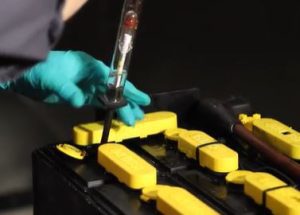Electric forklifts are crucial for the efficiency of warehouses and industrial operations, relying on industrial batteries for power. Proper maintenance, including regular watering, ensure optimal battery function. This guide offers comprehensive instructions on correct watering procedures for forklift batteries, emphasizing timing, safety measures, and necessary equipment.
watering procedures for forklift batteries, emphasizing timing, safety measures, and necessary equipment.
Why and When is Battery Watering Necessary?
Understanding the importance of watering forklift batteries is critical. Lead-acid batteries, commonly used in forklifts, require periodic watering to maintain optimal electrolyte levels. Water replenishment compensates for electrolyte evaporation during charging and discharging cycles. Forklifts used for one shift daily should be watered weekly, with more frequent watering necessary for multi-shift operations or when using reconditioned batteries. Watering should occur only when batteries are fully charged and cooled to avoid hazards.
Safety First
Safety is paramount before any maintenance on forklift batteries is conducted. Proper personal protective equipment (PPE), including goggles, gloves, aprons, and appropriate clothing, must be worn to shield against potential battery acid spills or splashes. Ensuring the forklift is turned off and parked on stable ground, as well as providing adequate ventilation to disperse hydrogen gas emitted during charging, are critical safety measures.
Determining the Need for Battery Watering
Preventing under or over-watering is vital for maintaining battery health. A visual inspection of electrolyte levels in each battery cell or utilizing float or eye indicators can help determine when watering is necessary. Following manufacturer instructions regarding specific indications for watering is recommended.
Items Needed
Several items are essential for effectively watering forklift batteries:
- Watering Jug or Watering Gun: Specialized tools for precise filling of each cell.
- Water: Use distilled or deionized water to prevent impurities from affecting battery performance.
- Personal Protection Equipment: Goggles, gloves, long sleeves, pants, closed-toe shoes, and an apron protect against battery acid exposure.
- Battery Watering System (optional but recommended): Automated systems simplify watering and ensure uniform distribution, reducing errors.
The Battery Watering Process (Manual)
For manual watering, follow these five steps:
- Locate battery fill holes or vent caps.
- Remove vent caps and slowly pour distilled water into each cell using a watering jug or gun.
- Fill each cell individually to ensure even distribution and stop when the correct level is reached.
- Avoid overfilling to prevent electrolyte spillage.
- Replace vent caps securely after watering to prevent evaporation and contamination.
Battery Watering Systems (Automated)
Automated systems offer a streamlined approach to watering:
- These systems connect to battery vent caps and automatically fill each cell to the appropriate level.
- Connect the system to a water source to eliminate the risk of over or underwatering.
- Improved efficiency and reduced time are the benefits of using battery watering systems.
By following these guidelines, forklift operators can their batteries’ longevity, performance, and safety, ultimately contributing to operational efficiency. Contact Abel Womack to learn more about all of our forklift energy solutions.




Leave a Reply
You must be logged in to post a comment.